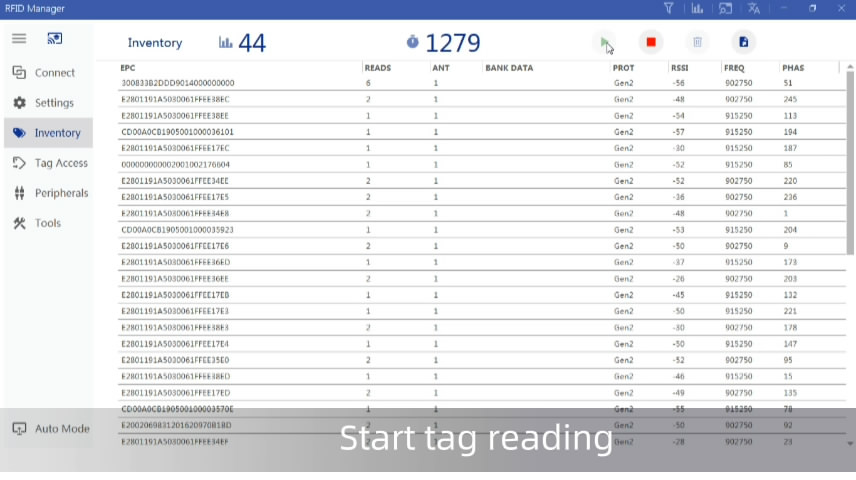Your location: Home Page > RFID Blog | SILION TECH > Effortless Integration with the SIM5100 UHF RFID Module I A Complete Tutorial I How to use UHF RFID Module SIM5100
News and Information
Effortless Integration with the SIM5100 UHF RFID Module I A Complete Tutorial I How to use UHF RFID Module SIM5100
Author:2023-06-30 19:40:41
Blog: Here is a step-by-step tutorial on how to use the UHF RFID Module SIM5100:
Hardware Setup:
-Connect the SIM5100 module to your device or system using the appropriate communication interface, such as a UART serial port.
-Make sure the power supply is within the specified range of 3.6V to 5.0V and connect it to the module.
-If you are using external antennas, connect them to the 50 Ω MMCX connector on the module.

Software Setup:
-Install the necessary drivers and software development kits (SDKs) provided by Silion Tech for the SIM5100 module.
-Depending on your programming language preference, download and install the corresponding host API for the SIM5100 (e.g., C, C#/.NET, or Java).
Establishing Communication:
-Use the appropriate software or programming language to open a serial communication port to connect with the SIM5100 module.
-Set the baud rate of the serial port to the specified range (e.g., 9600~921600bps) to match the module's communication settings.
Powering on the Module:
-Ensure that the power supply is connected and turned on.
-The module will initialize and enter a standby mode, ready for further commands.
Sending Commands:
-Using the chosen programming language, send commands to the SIM5100 module to perform specific actions.
-The commands will be in the form of strings or sequences of characters that follow a predefined protocol.
-Some common commands include reading tags, writing data to tags, and configuring module settings.

Reading Tags:
-To read tags, send the appropriate command to the module.
-The module will transmit radio frequency signals to detect nearby RFID tags.
-When a tag is detected, the module will receive and decode the tag's information, which can include unique identifiers or other stored data.
Writing Data to Tags:
-To write data to tags, send the corresponding command along with the data you want to write.
-Ensure that the tag is within range and compatible with the module's specifications.
-The module will transmit the necessary signals to write the data to the tag's memory.
Processing Data:
-Receive and process the data returned by the module after executing read or write commands.
-Depending on your application, you can extract and utilize the tag information for further processing, such as inventory management or asset tracking.
Handling Errors and Exceptions:
-Implement error handling mechanisms in your software to deal with potential errors or exceptions that may occur during communication or command execution.
-Error codes or messages provided by the module can help in troubleshooting and resolving issues.
Closing the Connection:
When you have finished using the module, close the serial communication port to terminate the connection properly.
Module Configuration:
The SIM5100 module may have configurable parameters such as output power, operating mode (fixed or hop frequency), and GPIO settings. Consult the module's documentation for details on how to configure these parameters to suit your specific requirements.
Command Structure:
Each command sent to the module follows a specific syntax or protocol defined by the module's firmware. It typically consists of a command header, command code, and optional parameters. Refer to the module's command set documentation to understand the specific command structure and available options.
Tag Filtering and Anti-Collision:
In scenarios where multiple RFID tags are present within the module's range, implementing tag filtering and anti-collision algorithms can improve efficiency. These algorithms help in identifying and processing tags one at a time, reducing collisions and ensuring accurate data capture. Check the module's documentation for guidance on implementing these features.
Data Encoding and Decoding:
RFID tags can store data in various formats, such as EPC (Electronic Product Code) or user-defined data. Make sure to understand the data encoding and decoding methods supported by the module. This will allow you to interpret the data received from tags correctly and encode data properly when writing to tags.
Error Handling and Response Parsing:
When communicating with the module, it is crucial to handle errors gracefully and parse the module's response messages accurately. Error codes or status information returned by the module can help identify issues during command execution. Implement proper error handling mechanisms and response parsing in your software to effectively manage errors and ensure reliable operation.
Remember, this tutorial provides a general overview of using the SIM5100 UHF RFID Module. For detailed and specific instructions, refer to the documentation and user manual provided by Silion Tech. It's also recommended to consult the technical support team for any further assistance or clarification.
By following these additional guidelines, you can enhance your understanding and implementation of the SIM5100 UHF RFID Module effectively. Always refer to the official documentation, user manual, and support resources provided by Silion Tech for comprehensive instructions and details specific to the module.